When I explained to my wife that I needed to remodel my work area, only as a step in remodeling the rest of our home, she was more than willing to allow me to dump my office stuff in various parts of the house. While I knew the high level of cooperation and support stemmed from my commitment to ever expanding refurbishing efforts, once my own office was completed, I liked it so much I never again came out for air, much less to work in any other area of our house.
My wife, quick to recognize my lack of progress (we’ve been married a long time), discovered she could hire contractors to pick up my slack, and get on with the rest of the home remodeling effort. Of course, since she had been kind enough to let me place the contents of my office in other parts of the home while my office was a work in progress, she apparently felt it would only be fair to put the balance of our home in my office while that construction was under way. I can’t locate the new Weatherby, it’s lost within some super compression of matter. 2000 sq ft of stuff just doesn’t compress into 144 sq ft of space, at least not like it use to. So I’m sitting on a painter’s tarp in the middle of what had been our living room, along with some small cardboard boxes that contain recently delivered components for the project gun. I’ll pick up the .257 WM project from here.
Wow ! Excellence in Sporting Goods
After deciding to get a Burris Signature scope, I started looking around the Internet. Model 200766 is a 4X-16X matte black scope, with Electro-Dot illuminated reticle, Posi-Locks for the optics, and adjustment for parallax correction. Suggested retail is $879; local retail store price $799, Midway USA, $559, Excellence in Sporting Goods $479. Several other Internet retailers listed models very similar to the 200766 at near the $479 price, however, each was missing at least one or more significant features. I made the purchase from Excellence in Sporting Goods. The scope shipped the day it was ordered and arrived on time. No sales tax, $6.50 delivery charge. They also had a .416 Euromark in stock, pretty much like the one I had on factory back order through a local retailer, only at a $300 lower price, and without a 90 days build date. Maybe next time.
(Update on Excellence in Sporting Goods) I went back two months later and purchased a second scope. The unit was a drop ship from Graf & Sons that arrived severely bent in a crushed container. I chased “Excellence” around for a month without results. They never would follow up on a conversation or initiate resolution of the problem, until I was forced to use the credit card company, supplying pictures of the damaged goods and proof of conversations, to have the charge removed from my bill. I even had to pay freight to return the item because “Excellence” would not issue an RMA. Sometimes it takes a problem situation to see what an operation is really made of. Sorry if you ran into a problem, they worked well the first time, but then there was no need for them to back up a sale with service.
This is no reflection on the scope in this article, which has seen continual heavy use and performs better than advertised.
The Burris Signature Model 200766
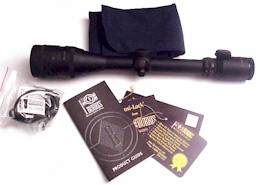 The scope, as might be expected in a 16X product, is not small, but it’s not out of line with the competition. Length 15.2 inches, weight 23 ounces, including batteries. The objective lens is 44mm seated in a 60mm bell. The little things that came with the scope were the result of thoughtful packaging, and consistent with my prior experience with Burris; scope caps, protective cloth pouch for use when the scope’s off the rifle, a fresh battery, special feature literature, and a comprehensive user’s manual. It always irritates me when I get a new Leupold scope that doesn’t come even with a set of cheap throwaway caps to protect lenses in initial handling.
The scope, as might be expected in a 16X product, is not small, but it’s not out of line with the competition. Length 15.2 inches, weight 23 ounces, including batteries. The objective lens is 44mm seated in a 60mm bell. The little things that came with the scope were the result of thoughtful packaging, and consistent with my prior experience with Burris; scope caps, protective cloth pouch for use when the scope’s off the rifle, a fresh battery, special feature literature, and a comprehensive user’s manual. It always irritates me when I get a new Leupold scope that doesn’t come even with a set of cheap throwaway caps to protect lenses in initial handling.
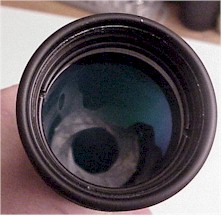 Image Quality – In prior articles, I made the comment that the best scope image I’ve seen came from an old inexpensive Tasco variable. The scope remains a permanent fixture on my 7mm mag. Colors are bright, there is no gray haze from optical flare or interior reflection, and it’s easy to pick out the smallest detail at the target. Today there is so much glass hanging off the end of a high magnification scope, it’s very difficult to get that same image quality. Burris seems to have a handle on the situation. The three examples of Burris product I’ve used have image quality very similar to the old Tasco. In fact, Burris went one step further.
Image Quality – In prior articles, I made the comment that the best scope image I’ve seen came from an old inexpensive Tasco variable. The scope remains a permanent fixture on my 7mm mag. Colors are bright, there is no gray haze from optical flare or interior reflection, and it’s easy to pick out the smallest detail at the target. Today there is so much glass hanging off the end of a high magnification scope, it’s very difficult to get that same image quality. Burris seems to have a handle on the situation. The three examples of Burris product I’ve used have image quality very similar to the old Tasco. In fact, Burris went one step further.
Recognizing a scope may be used under extreme light conditions, Burris avoided the foot long sunshade attachment solution and added “The Light Collector™”. Basically, they installed an iris behind the objective lens so the shooter can open and close the aperture to control the amount of light passing through the scope. I closed the iris down in the picture on the right so the reduced aperture can been seen. Light Collector opened, or closed, the image is great; no haze, bright color – things I’ve missed in the Leupold Vari-X III scopes I’ve purchased. It also seems Leupold scopes have a soft image, not out of focus, but not sharply defined. The Burris produced a clear, sharp image.
If you look toward the top of the lens, just inside the bell, you’ll see a long bright line of bare metal. There were actually several similar marks and, additionally, the lock ring that secured the lens was a little “chewed”. I use to think the dealer was shipping blemished or used stock, but in fact this appears to be the normal condition of product leaving Burris, as every single scope I’ve received has the same assembly damage. These defects cause flare and a reduction in image quality. I wouldn’t expect to see such an obvious defect in a $20 camera, much less a $500 scope. A touch up pen covered the bright spots but, for this level of expenditure, I’d be embarrassed if I shipped product with such a preventable defect. The interior of the scope appeared to be dust and scratch free, uniform in flat black coating, an area more critical to image quality. The Daylight – Twilight markings in the picture below represent the control of the Light Collector feature.
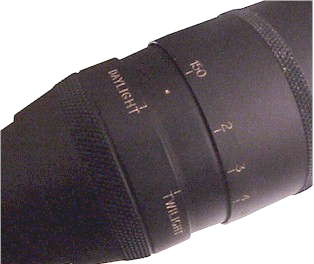 Parallax Adjustment – If you move your eye away from the center of your scope, and the reticle appears to move over the fixed target, you are experiencing parallax. This is caused by a slight out of focus conditions that exist in any scope over a broad range of distances. High magnification scopes tend to amplify this condition. The 200766 comes with a parallax adjustment that moves the objective lens in and out, allowing critical focus progressively from 50 yards out to infinity.
Parallax Adjustment – If you move your eye away from the center of your scope, and the reticle appears to move over the fixed target, you are experiencing parallax. This is caused by a slight out of focus conditions that exist in any scope over a broad range of distances. High magnification scopes tend to amplify this condition. The 200766 comes with a parallax adjustment that moves the objective lens in and out, allowing critical focus progressively from 50 yards out to infinity.
As a side note, you may have noticed many features that appear on high magnification scopes are only necessary as a result of their high magnification. While these features permit you to tune the scope to your specific purposes, they also make the product more complex, more prone to break, and add significantly to weight. As an example, the parallax adjustment adds 1.5 ounces to the scope, and increase of 6%. I would assume the Light Collector would be worth another 3 ounces, the posi-locks another 2 or so…wouldn’t take much to get to a pound.
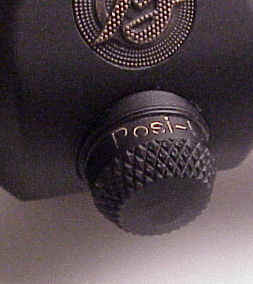 Posi-Locks – Toward the bottom of the scope turret is a Posi-Lock adjustment. Scopes are comprised of an outer and inner tube. The inner tube carries the optics, and alignment relative to the rifle bore and scope outer tube is established through windage and elevation adjustment. A turn on the windage or elevation knob moves a post against the inside tube, and an opposing spring presses against the inside tube so it follows the movement of the adjustment post as it moves in and out in adjustment. Essentially, the inside tube floats within the outside tube, and springs insure the assembly returns to it’s original position after the gun is fired. Non posi-lock Burris scopes have twice the industry average spring rates, about 14 lbs.
Posi-Locks – Toward the bottom of the scope turret is a Posi-Lock adjustment. Scopes are comprised of an outer and inner tube. The inner tube carries the optics, and alignment relative to the rifle bore and scope outer tube is established through windage and elevation adjustment. A turn on the windage or elevation knob moves a post against the inside tube, and an opposing spring presses against the inside tube so it follows the movement of the adjustment post as it moves in and out in adjustment. Essentially, the inside tube floats within the outside tube, and springs insure the assembly returns to it’s original position after the gun is fired. Non posi-lock Burris scopes have twice the industry average spring rates, about 14 lbs.
Posi-Lock equipped scopes replace the standard loading spring setup with a steel rod, and a 14 lbs spring running down its center. With posi-lock in use, a steel rod literally locks the inside tube’s position, relative to the outside tube. With posi-lock off, the inside tube is still held with 14 lbs of spring pressure and your gun may be fired normally. So after you get your rifle sighted in, you can elect to twist the posi-lock screw in, or leave it out. I’ve tried both positions on heavy recoil guns and have not noticed a difference. I’m probably missing a point, but I think I’m more concerned with the potential for shock transmission through the more solid posi-lock assembly, than the normal shock dampened approach to return the assembly back to the correct position.
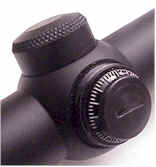 Windage and elevation adjustments – The Model 200766 comes with Hunter, or low profile, adjustment knobs. You can get the high target style on special order for a cost of about $80. I personally like the low profile type because they stay out of your way and they don’t get hung up in cases or on the edge of a shooting bench. Beside, and maybe it’s just me, but once my scope is set up, it doesn’t seem to need all that much further adjustment.
Windage and elevation adjustments – The Model 200766 comes with Hunter, or low profile, adjustment knobs. You can get the high target style on special order for a cost of about $80. I personally like the low profile type because they stay out of your way and they don’t get hung up in cases or on the edge of a shooting bench. Beside, and maybe it’s just me, but once my scope is set up, it doesn’t seem to need all that much further adjustment.
The adjustment increments are .250″ at 100 yards per click. The overall available adjustment is 32″ at 100 yards which is actually quite narrow compared to the higher end Black Diamond series, or lower end Fullfield. I’m not sure what the practical impact will be, perhaps just being more careful installing the mounts and bore sighting the scope. Clearly I’m going to want to keep the adjustments as close to center of the range as possible.
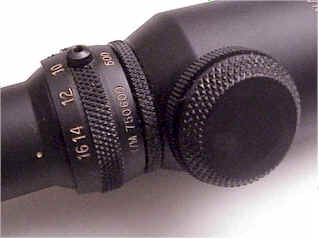 Zoom & Rangefinder – The first knurled ring on the left controls the zoom and range estimator functions. The zoom adjustment is straight forward, the range estimator left me…..well, conceptually challenged. Basically, if you look at something known to be approximately 18″ in size, and you zoom the scope until that object fills the area between the center of the cross hairs and where the cross hairs expand from thin to thick, the range index on the zoom ring will tell you how far off the object is. I suppose the feature is okay, but I tend to shoot whatever shows up for that long in my scope, versus use the time to start playing with scope adjustment.
Zoom & Rangefinder – The first knurled ring on the left controls the zoom and range estimator functions. The zoom adjustment is straight forward, the range estimator left me…..well, conceptually challenged. Basically, if you look at something known to be approximately 18″ in size, and you zoom the scope until that object fills the area between the center of the cross hairs and where the cross hairs expand from thin to thick, the range index on the zoom ring will tell you how far off the object is. I suppose the feature is okay, but I tend to shoot whatever shows up for that long in my scope, versus use the time to start playing with scope adjustment.
 Electro Dot – The scope ships with a standard plex type reticle. As a person who primarily uses a fine reticle, the step down to fine reticle area is large enough so the target never seems obstructed, but the thicker outside portions of the cross hair really help in getting on target. Burris offers a variety of reticles as extra cost options. I really like the Electro Dot feature. It only illuminates the standard center of the reticle, it is adjustable for brightness, and works really well against a shadowed or dim background. My only concern would be how reliable it would function in very cold weather where camera batteries seem to croak on a regular basis. The Electro Dot is powered by a common 3v camera battery and is designed to last a minimum of 12 hours, more typically 24 – 36 hours, at full power. The Electro Dot is not designed to be left powered on. In the event of a dead battery, the scope continues to function normally, with the exception of the little red dot. Oh, almost forget, the Electro Dot is .180″ in diameter at 100 yards.
Electro Dot – The scope ships with a standard plex type reticle. As a person who primarily uses a fine reticle, the step down to fine reticle area is large enough so the target never seems obstructed, but the thicker outside portions of the cross hair really help in getting on target. Burris offers a variety of reticles as extra cost options. I really like the Electro Dot feature. It only illuminates the standard center of the reticle, it is adjustable for brightness, and works really well against a shadowed or dim background. My only concern would be how reliable it would function in very cold weather where camera batteries seem to croak on a regular basis. The Electro Dot is powered by a common 3v camera battery and is designed to last a minimum of 12 hours, more typically 24 – 36 hours, at full power. The Electro Dot is not designed to be left powered on. In the event of a dead battery, the scope continues to function normally, with the exception of the little red dot. Oh, almost forget, the Electro Dot is .180″ in diameter at 100 yards.
The Burris Forever Warranty – The scope mechanical portion of the scope is covered for life, even if it changes ownership. Electronics portions of the scope (Electro Dot) are covered for 5 years. I’ve never sent a scope in for repair so I have no gauge for rating the warranty or quality of service. There are so many disclaimers in all of these optical product warranties, coverage really depends on the attitude and quality of the organization. I just have no first hand experience with product service, although I have excellent results from their tech support staff.
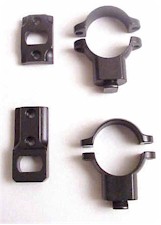 Mounts – I’m sure I violated some scope mounting ritual and tradition by purchasing Leupold mounts rather than Burris. I just happen to like Leupold mounts, and they seem to fit more guns properly than Burris Signature hardware. I’m using twin dovetail and use Torx fasteners.
Mounts – I’m sure I violated some scope mounting ritual and tradition by purchasing Leupold mounts rather than Burris. I just happen to like Leupold mounts, and they seem to fit more guns properly than Burris Signature hardware. I’m using twin dovetail and use Torx fasteners.
As suggested by Brownells Tech for proper scope clearance, I selected Super High 1″ rings. I usually like to get the scope bell almost dragging on the barrel taper, but I’ll take a chance and start here and see how it works out. The front mount is reversible and can be flopped round to change ring spacing.
There are different scope mount system part numbers for different models and calibers of Ultra Lightweight Weatherby rifles. In this case the mounts are Leupold 51706 (matte) and 49919 (matte) for rings.
Scope Summary
The scope will fit in well with the .257 Weatherby and will stand up, without a problem, to any recoil related issues. It seems well made, adjustments are smooth and positive and the image quality is exceptional. When I’m done working with the .257 WM, I thought I’d move the scope over to the .338-378 Accumark and get a direct comparison with the 3X-10X 50mm Leupold that is currently installed. By next week I should have my office returned to normal again, I hope, and I’ll be able to get more functional firearms check outs accomplished.
I wish the firearms related industries, and firearms related sports, were in better shape. I always get concerned that manufacturers will not invest in necessary R&D efforts. 10 years ago, a 35 mm camera micro circuits and programming could range find, auto focus, adjust for light conditions, and control aperture. Would be nice to have a scope with a small jack that would permit me to plug in a small keyboard, or interface to my PC, so I could program in bullet trajectory after a preliminary sighting in, then the scope would sort out the rest…of course that would need to be in a package that weighed less than 15 lbs, didn’t need Ford truck battery for power and was priced below the $500 mark.
More “The .257 Weatherby Ultra Lightweight”:
Pick up Day for the .257 Weatherby Ultra Lightweight
Scope selection for the .257 Weatherby project
.257 Weatherby handloading assessment
The Weatherby Mark V .257 WM at the range
Reloading the .257 WM …in excruciating detail Part I
Reloading the .257 WM …in excruciating detail Part II
Handload Data 257 Weatherby Magnum
Thanks,
Joe

Email Notification